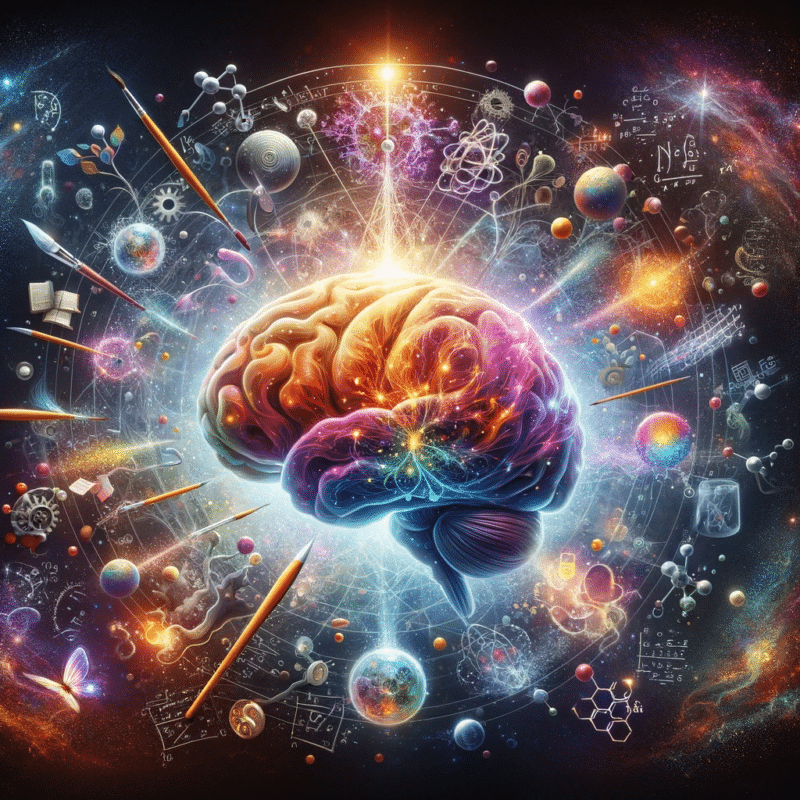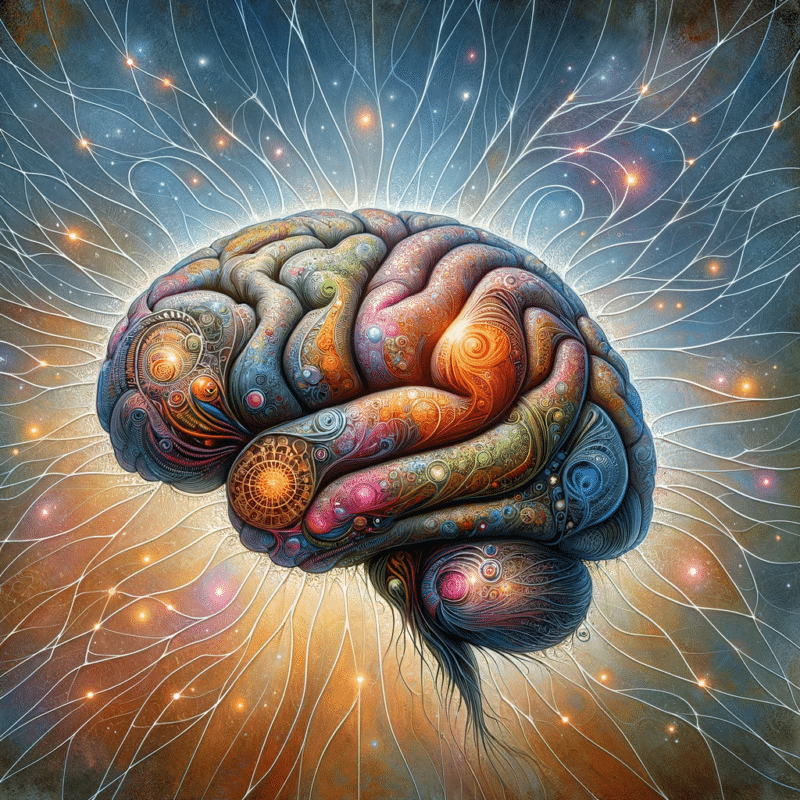Harnessing the Power of Positivity: Affirmational Art and Brain Plasticity delves into the fascinating interplay between inspirational art and the malleability of the human brain. This article explores the scientific underpinnings of how positive visual stimuli can not only enhance creativity and productivity but also fundamentally reshape our neural pathways, leading to improved mental health. Drawing from empirical studies and neuroscience research, it offers practical advice for incorporating affirmational art into everyday life to reap its cognitive and emotional benefits.
Key Takeaways
- Motivational wall art is linked to increased workplace efficiency and creativity, underpinning the science of inspiration.
- Positive affirmations can lead to significant changes in brain plasticity, affecting adaptability and mental well-being.
- The integration of affirmational art with cognitive behavioral therapy can help recondition thought patterns for better mental health.
- Personalized affirmational art can be strategically designed and integrated into daily life for maximum cognitive and emotional benefit.
- Empirical evidence and case studies demonstrate the long-term positive impact of affirmational art on productivity and mental health.
The Science Behind Inspiration

Motivational Wall Art and Workplace Efficiency
In the realm of office aesthetics, inspirational wall art has emerged as a key player in enhancing the ambiance and boosting employee morale. The presence of inspirational posters in the workplace is not just a decorative choice but a strategic one. These visual cues serve as constant reminders of a company’s values and aspirations, subtly influencing the mindset and productivity of its workforce.
The strategic placement of inspiration wall art for office spaces can be a game-changer in cultivating a culture of motivation and efficiency.
A study conducted across various industries revealed a notable increase in workplace efficiency upon the introduction of motivational art. The following table summarizes the findings:
| Industry | Efficiency Increase (%) | Type of Art |
|---|---|---|
| Tech | 15 | Inspirational Posters |
| Finance | 10 | Canvas Quotes |
| Healthcare | 20 | Framed Affirmations |
The data underscores the tangible benefits of integrating affirmational art into the work environment. Employees report feeling more inspired and aligned with their work, leading to a more vibrant and productive office culture.
Artistic Influences on Creativity
The intersection of art and the human brain reveals a fascinating synergy. Engaging in creative activities is not just a means of self-expression but also a powerful catalyst for cognitive development. When we immerse ourselves in the process of creating art, we are essentially sculpting our brain’s architecture; this act of creation fosters an increase in brain plasticity, allowing for new neural connections to flourish.
- Artistic endeavors stimulate the mind, encouraging divergent thinking and problem-solving skills.
- Exposure to art can enhance cognitive abilities, leading to more innovative thought processes.
- Regular participation in artistic activities has been linked to improved mental agility and an expanded capacity for learning.
The consistent engagement with art can subtly shift our cognitive patterns, promoting a more creative and flexible mindset.
In the context of affirmational art, the messages embedded within the artwork serve as seeds for thought, which, when nurtured by the fertile ground of an open mind, can blossom into profound insights and ideas. The ‘Good Vibes Only’ store exemplifies this concept, offering a space where art is not just seen but experienced, with each piece designed to resonate with the viewer on a deeper level.
Empirical Evidence: Productivity Studies
Recent studies have begun to quantify the impact of affirmational art on workplace productivity. A significant correlation has been found between motivational visuals and improved employee output. For instance, a controlled experiment within a corporate setting revealed that teams exposed to affirmational wall art reported a 15% increase in productivity compared to those in a neutral environment.
| Environment | Productivity Increase |
|---|---|
| Affirmational Art | 15% |
| Neutral | 0% |
This data suggests that the presence of an inspirational poster or motivational wall art with symbols of empowerment and personal growth can have a tangible effect on work efficiency. Such visuals encourage viewers to embrace their journey with courage and belief in their potential, fostering an atmosphere conducive to enhanced performance.
The integration of affirmational art in the workplace is not just about aesthetics; it’s a strategic move towards cultivating a more dynamic and inspired workforce.
Moreover, the commercial availability of such art is expanding. Inspirational wall art at the Good Vibes Only Store ranges from affordable to premium, making it accessible for businesses a of various sizes to invest in this productivity-boosting tool.
The Neuroscience of Affirmation Art

Positive Messages and Brain Adaptability
The human brain is remarkably adaptable, capable of forming new neural connections throughout life. Positive affirmations can significantly influence this adaptability, shaping the way we think and respond to our environment. When exposed to affirmational art, the brain’s neural pathways can be encouraged to reorganize in a more positive framework.
- Exposure to positive messages can lead to increased feelings of self-efficacy.
- Regular interaction with affirmational art can enhance cognitive flexibility.
- Positive imagery in one’s surroundings can act as a catalyst for a more optimistic outlook.
The consistent presence of positive stimuli is not just a momentary lift but can contribute to a sustained enhancement in mood and cognitive function.
Research has shown that environments enriched with positive messages, like those found in affirmational art, can foster a mindset that is more open to change and growth. For instance, a ‘Spread Happiness’ poster might not only brighten a space but also serve as a daily reminder to embrace joy and positivity.
Neuroplasticity: The Brain’s Response to Affirmations
The concept of neuroplasticity underscores the brain’s remarkable ability to reorganize itself by forming new neural connections throughout life. This adaptability is at the heart of how affirmations influence our mental landscape. Because positive affirmations work by replacing negative thought patterns with healthier ways of thinking, they can have a positive impact on the brain and body, fostering an environment conducive to growth and change.
The consistent use of affirmational art can serve as a catalyst for this transformative process, subtly reinforcing the positive narratives that we wish to embody.
Understanding the mechanisms through which affirmations affect the brain involves recognizing the role of repetition and emotional engagement. Here is a list of key factors that contribute to the brain’s response to positive stimuli:
- Repetition of affirmations strengthens neural pathways.
- Emotional resonance enhances the retention of positive messages.
- Visualization associated with affirmational art can activate similar brain regions as actual experience.
- The presence of positive art can serve as a reminder to maintain a positive mindset.
Long-Term Impact of Positive Stimuli on Mental Health
The incorporation of positive stimuli in our environment can have a profound and enduring effect on mental health. Exposure to affirmational art over time can significantly alter our core schema, potentially mitigating maladaptive cognition, particularly in individuals with depression. This transformative power of aesthetic chills, or the emotional response to particularly moving pieces of art, underscores the therapeutic potential of positive triggers in our surroundings.
- Aesthetic chills as a response to affirmational art
- Mitigation of maladaptive cognition
- Transformation of core schema in depression
The consistent interaction with positive imagery and messages fosters a mental landscape where positivity is not just a fleeting moment, but a foundational aspect of thought patterns.
The long-term engagement with affirmational art is not just about momentary upliftment but about fostering a sustained positive outlook. By regularly encountering positive triggers, individuals can reshape their emotional responses, leading to a healthier mental state over time.
Transforming Thoughts: The Role of Affirmational Art in Cognitive Reconditioning

Rewiring the Brain with Positive Imagery
The human brain is remarkably adaptable, capable of forming new connections and pathways when exposed to new experiences or environments. Positive imagery, particularly through affirmational art, plays a pivotal role in this process of cognitive reconditioning. By consistently surrounding ourselves with positive visual cues, we can effectively rewire our thought patterns and emotional responses.
The practice of integrating positive imagery into our daily lives is not just about creating a pleasant environment; it’s a form of mental training that can lead to profound changes in our brain’s structure and function.
Repetition is key to this transformation. Just as athletes train their muscles through consistent practice, individuals can train their brains to lean towards positivity through the regular exposure to affirmational art. This concept is supported by the idea that training motor imagery achieves use-dependent plasticity in the brain, which is a change that occurs as a result of repeated mental activity.
Positive affirmations, when repeated, forge new neural pathways in the brain. This makes the recurrence of positive thoughts and feelings more natural over time. It’s a process that not only reshapes our internal dialogue but also has the potential to reduce stress and improve overall mental health. The following list outlines the steps involved in using affirmational art to rewire the brain:
- Select affirmational art that resonates with personal values and aspirations.
- Place the art in a frequently viewed location to ensure regular exposure.
- Engage with the art daily, taking a moment to reflect on its message.
- Observe and document any changes in thought patterns or emotional responses over time.
Cognitive Behavioral Therapy and Visual Affirmations
Cognitive Behavioral Therapy (CBT) is a well-established psychological treatment that often incorporates the use of affirmational art to enhance its effects. Visual affirmations can serve as powerful tools for individuals undergoing CBT, helping to reinforce positive thought patterns and behaviors.
The integration of visual affirmations into CBT sessions can be structured in various ways, including:
- Daily viewing of affirmational art
- Creation of personal affirmation cards
- Use of visual cues to trigger positive thinking
The consistent exposure to positive imagery and affirmations can lead to a strengthening of self-integrity and a more resilient sense of personal adequacy.
Moreover, the ‘Clouds of Happiness‘ concept, where elements like smiling clouds and a vibrant rainbow are used, exemplifies how artistic representations can embody joy and positivity, potentially influencing mood and cognitive processes.
Case Studies: Success Stories of Affirmational Art
The transformative power of affirmational art is not just theoretical; it’s evidenced by numerous success stories. Individuals and organizations alike have reported significant shifts in mindset and behavior after incorporating positive imagery into their environments.
- The Good Vibes Only Store is a prime example of success through positive messaging. Their range of wooden art and paper posters has not only brightened spaces but also uplifted spirits, leading to a strong customer base and active social media engagement.
- In the academic realm, a study titled ‘Physical Activity and Cognitive Functioning‘ published by MDPI highlights the benefits of motor and sports activity on brain functions. The research suggests that such activities, akin to the effects of affirmational art, enhance brain efficiency, plasticity, and adaptability, contributing to improved memory and cognitive health.
The consistent exposure to affirmational art can be likened to a cognitive workout, strengthening the mental muscles of positivity and resilience.
Maximizing the Benefits of Affirmational Art

Strategies for Integrating Positive Art in Daily Life
Incorporating affirmational art into your daily environment can be a transformative practice. To ensure lasting results, it’s essential to integrate positive affirmations into your daily routine. Visualizing and feeling the affirmation as you encounter the art can deepen its impact, allowing you to embody the qualities or outcomes you desire.
- Select locations that you frequently visit throughout the day for placing affirmational art. This could be your workspace, bedroom, or even your digital devices’ wallpapers.
- Rotate your art pieces periodically to keep the messages fresh and engaging.
- Incorporate variety by using different types of affirmational art, such as posters, sculptures, or digital art.
By consciously engaging with affirmational art on a regular basis, you create a positive feedback loop that reinforces your desired mindset and behaviors.
For those interested in purchasing affirmational art, consider exploring options such as the Good Vibes Only Store in San Diego, which features a variety of wall art posters. Their website page also provides related products and contact information for further inquiries.
Designing Personalized Affirmational Art
Creating personalized affirmation wall art is a deeply personal and creative process that can significantly enhance the positive atmosphere of any space. The key to effective affirmation art is ensuring that it resonates with your personal aspirations and values.
To begin, select affirmations that are meaningful to you and consider the design elements that will best convey your message. Whether it’s an affirmation poster for your office or an affirmation wall in your home, the visual appeal is just as important as the words themselves.
- Choose affirmations that inspire and motivate you
- Decide on a color scheme that uplifts your mood
- Select fonts that reflect the energy of your affirmations
- Determine the size and placement of your affirmation art for maximum impact
The process of creating affirmation art is not just about decoration; it’s an act of self-care and personal development.
Remember, the goal is to create a piece of art that not only beautifies your environment but also serves as a constant reminder of your goals and the mindset you wish to cultivate. By integrating personalized affirmation art into your daily life, you can create a powerful tool for cognitive and emotional health.
Measuring the Impact on Cognitive and Emotional Health
To effectively gauge the influence of affirmational art on cognitive and emotional well-being, a multi-faceted approach is essential. Quantitative assessments can provide concrete data on the cognitive improvements, while qualitative feedback can offer insights into the emotional and psychological shifts experienced by individuals.
- Pre- and post-intervention cognitive tests
- Self-reported mood and stress levels
- Longitudinal tracking of behavioral changes
These methods combined can paint a comprehensive picture of the art’s impact. For instance, cognitive tests might reveal enhancements in executive functions (EFs), a finding supported by research suggesting that therapeutic approaches like gaming can boost brain plasticity and improve EFs.
The integration of music and art in affirmations can amplify their effectiveness, with music’s stress-reducing and concentration-improving properties complementing the visual stimuli.
Ultimately, the goal is to establish a clear link between the presence of affirmational art and positive changes in mental health, thereby validating its use as a tool for cognitive and emotional enhancement.
Discover the transformative power of affirmational art and how it can inspire positivity in your daily life. Our carefully curated collection of posters, accessories, and more is designed to uplift and motivate. Don’t just take our word for it, experience it for yourself. Visit our website and explore our range of products that embody the essence of good vibes. Make your space a sanctuary of inspiration—start your journey with us today!
Embracing the Art of Positivity for Cognitive and Emotional Flourishing
In conclusion, the interplay between affirmational art and brain plasticity offers a compelling glimpse into the transformative power of positivity. As we have explored, motivational wall art does more than decorate a space; it serves as a catalyst for productivity and creativity by influencing our neural pathways. The science of inspiration underscores the tangible benefits of positive affirmations, reshaping our brains to foster a mindset conducive to mental well-being. By integrating practical tips for utilizing affirmational art into our daily lives, we can harness this power to not only enhance cognitive function but also to cultivate an environment of emotional health. Ultimately, the art of positivity is not just an aesthetic choice but a deliberate step towards personal growth and resilience.
Frequently Asked Questions
How does motivational wall art affect workplace efficiency?
Motivational wall art can boost workplace efficiency by enhancing the environment, providing visual cues that remind employees of their goals and aspirations, and fostering a positive mindset that can lead to increased focus and productivity.
In what ways can artistic influences boost creativity?
Artistic influences can stimulate the brain’s creative processes by exposing individuals to new perspectives, ideas, and emotional responses. This exposure can encourage innovative thinking and the generation of original ideas.
Is there empirical evidence that affirmational art improves productivity?
Yes, there are productivity studies that suggest a correlation between affirmational art and improved productivity. These studies indicate that positive stimuli in the work environment can lead to better performance and higher job satisfaction.
How do positive messages affect brain adaptability?
Positive messages can influence brain adaptability by reinforcing neural pathways associated with positive thinking. This reinforcement can enhance the brain’s ability to adapt to new challenges and learn from positive experiences.
What is the long-term impact of positive stimuli on mental health?
Long-term exposure to positive stimuli, such as affirmational art, can have a profound impact on mental health. It can lead to improved mood, reduced stress levels, and a greater sense of well-being, contributing to overall mental resilience.
Can affirmational art be integrated into cognitive behavioral therapy?
Yes, affirmational art can be integrated into cognitive behavioral therapy (CBT) as a tool for reinforcing positive thought patterns and behaviors. Visual affirmations can serve as reminders of the cognitive restructuring that takes place during CBT sessions.



